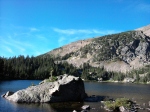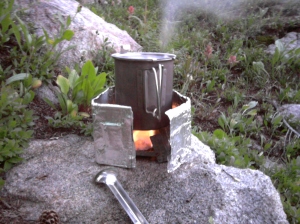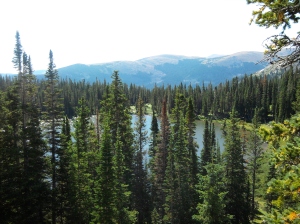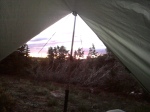Saturday, May 26, to Sunday, May 27, 2012
My buddy Ian joined me for a fly fishing backpacking trip to Red Deer Lake in the Indian Peaks Wilderness to kick off my 2012 backpacking season. We were rewarded with perfect weather and pleasant temperatures.
At the junction of the Buchanan Pass Trail and the half-mile spur that goes west and steeply up to the lake, we found the trail was buried deeply under snow. We followed a bearing of 300 degrees and post-holed our way up to the lake. We camped on the saddle on the north side of the lake which was free of snow.
We didn’t get a nibble from the trout, but we did see a few fish rising and even a couple jumping despite what I thought must be early season torpor among the rest of the fish.
Ian brought along his new MSR Pocket Rocket, and that stove made meal prep a much more routine process than some of our past backcountry dinners. I’m sure we’ll miss his Snow Peak stove — the fondly named, but now-retired “Fireball.”
It was a short and sweet start to the season.
Destination: Red Deer Lake, Indian Peaks Wilderness, southwest of Allenspark, Colorado
Distance hiked: about 12 miles round-trip. We hiked the Buchanan Pass Trail going in (6.7 miles) from the trailhead west of Camp Dick (rather than the trailhead at the terminus of the 4WD road), but we short-cut parts of that trail coming back out. We traveled off-trail coming back down from the lake because the north-facing trail was lost under snow sometimes four or five feet thick.
Elevation: We started at about 9,400 feet. We slept at about 10,500 feet.
Weather: sunny and clear, some strong wind gusts. The forecasts for the nearby towns (at lower elevations) were calling for gusts up to 36 mph and lows in the 30s. I don’t know the Beaufort scale that well, but I think we encountered gusts greater than 40 mph at our elevation. When I was packing for the trip I predicted a a low of 29 degrees F, based on elevation. I was a bit off.
Temperatures: low to mid 60s during the afternoon; low of 24 degrees F at about 4:00 in the morning according to my Casio Pathfinder
Pack Weight: about 19 pounds, including consumables. I carried 2 liters of water each way. On the way in, I drained my Camelbak completely. On the way out, I barely touched the water. I was definitely feeling the elevation on the way in.
My spreadsheet detailing equipment list and weights is available as a PDF on on Google docs here. (I bought a postal scale this past winter and started making spreadsheets to get serious about lowering my pack weight.)
Notes: I did a decent job estimating the overnight low temperature, but I did not anticipate how forceful the wind gusts would be. Saturday night I had an attitude-induced headache. I wish I had gone ahead and taken some ibuprofen because the headache lasted most of the night despite my drinking lots of liquids.
Photos:

The snowpack on the southwestern end of the lake was “calving” into the lake throughout the night. It looked different in the morning.

I had just bought the Big Agnes Fly Creek UL2. It was lightweight at about 2 pounds with just the rainfly, pole and ground cloth. But it did not do well in the wind, even with all 13 guylines/tiedowns in place. It did not accommodate two six-foot-tall men very well. If there had been condensation, I think the footboxes of our down sleeping bags would have been wet from contact.

Ian fishes Red Deer Lake with little success for catching trout. But the views were still worthwhile.

I took this and the other panoramas with my Samsung Galaxy Nexus phone. I really like the camera’s panorama mode.




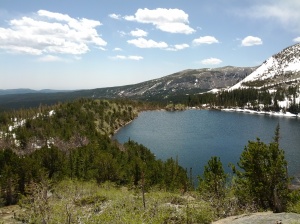




 Posted by Joe Mason
Posted by Joe Mason 
